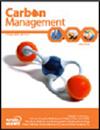Improvement in soil quality through tillage and residue management in Jute (Corchorus spp.) based cropping systems of Indo-Gangetic plains
IF 3.2
4区 环境科学与生态学
Q3 ENVIRONMENTAL SCIENCES
引用次数: 1
Abstract
Abstract The changes in soil quality in terms of carbon accumulation, aggregate stability and enzyme activity were evaluated in Jute based cropping systems (jute-rice-wheat, jute-rice-lentil and jute-rice-mustard) subjected to various tillage systems, i.e. conventional tillage (CT), no tillage (NT) and no tillage with additional crop residue retention (NTR) under tropical climate of Indo-Gangetic plains. The crops were grown with conventional (disc plowing, followed by 2 cultivators) and no tillage (no ploughing) and additional crop residues were applied as Sesbania spp. with a rate of 2 t ha−1. Addition of crop residue under no tillage improved bulk soil organic carbon (SOC), particulate SOC content (PSOC) and aggregate stability, promoting a better soil physico-chemical behavior in all crop-rotations. The SOC contents under No tillage with residue incorporated plots (NTR) are much higher, maximum being in jute-rice-lentil (6.02 and 7.29 g kg−1, respectively in 0–0.15 and 0.15–0.30 m soil depth). The highest SOC density (330.03 g C m−2) and stock (3.30 Mg C ha−1) were recorded in the NT R. Soil microbial biomass (SMBC) was significantly higher in NT R (range: 641.84 to 745.97 µg g −1) followed by NT (631.42 to 678.46 µg g −1) and CT (490.68 to 634.83 µg g −1). Jute equivalent yield (JEY) was highest in jute-rice-lentil (J-R-L) under NTR (7.33 t ha−1). Thus, no tillage with residue incorporation under Jute-rice-lentil system is highly beneficial in maintaining crop productivity and improving soil quality.印度-恒河平原黄麻种植系统中耕作和残留物管理对土壤质量的改善
摘要评价了黄麻种植系统(黄麻-水稻-小麦、黄麻-水稻扁豆和黄麻-水稻芥末)在不同耕作制度(即常规耕作(CT))下土壤质量在碳积累、团聚体稳定性和酶活性方面的变化,印度-恒河平原热带气候下的免耕(NT)和附加作物残留量的免耕(NTR)。作物采用常规(圆盘犁,然后是2台耕耘机)和免耕(免耕)种植,并以Sesbania spp.的形式施用额外的作物残留物,施用率为2 t ha−1。免耕条件下添加作物秸秆提高了土壤有机碳(SOC)、颗粒物有机碳含量(PSOC)和团聚体稳定性,促进了所有轮作中更好的土壤理化行为。免耕留渣小区土壤有机碳含量较高,黄麻-水稻扁豆土壤有机碳最高(6.02和7.29) g kg−1,分别在0–0.15和0.15–0.30 m土壤深度)。最高SOC密度(330.03 g C m−2)和库存(3.30 Mg C ha−1)记录在NT中 R.NT的土壤微生物生物量(SMBC)显著较高 R(范围:641.84至745.97µg g−1),然后是NT(631.42至678.46µg g-1)和CT(490.68至634.83µg g-1)。在NTR(7.33 t ha−1)条件下,黄麻-水稻扁豆(J-R-L)的黄麻当量产量(JEY)最高。因此,在黄麻-水稻-扁豆体系下进行秸秆还田对保持作物生产力和改善土壤质量非常有益。
本文章由计算机程序翻译,如有差异,请以英文原文为准。
求助全文
约1分钟内获得全文
求助全文
来源期刊

Carbon Management
ENVIRONMENTAL SCIENCES-
CiteScore
5.80
自引率
3.20%
发文量
35
期刊介绍:
Carbon Management is a scholarly peer-reviewed forum for insights from the diverse array of disciplines that enhance our understanding of carbon dioxide and other GHG interactions – from biology, ecology, chemistry and engineering to law, policy, economics and sociology.
The core aim of Carbon Management is it to examine the options and mechanisms for mitigating the causes and impacts of climate change, which includes mechanisms for reducing emissions and enhancing the removal of GHGs from the atmosphere, as well as metrics used to measure performance of options and mechanisms resulting from international treaties, domestic policies, local regulations, environmental markets, technologies, industrial efforts and consumer choices.
One key aim of the journal is to catalyse intellectual debate in an inclusive and scientific manner on the practical work of policy implementation related to the long-term effort of managing our global GHG emissions and impacts. Decisions made in the near future will have profound impacts on the global climate and biosphere. Carbon Management delivers research findings in an accessible format to inform decisions in the fields of research, education, management and environmental policy.
 求助内容:
求助内容: 应助结果提醒方式:
应助结果提醒方式:


